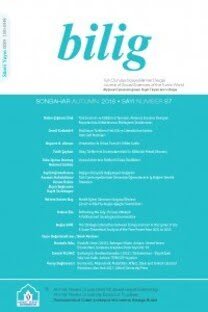Kağanlık ve Kamlık Kurumları Arasındaki Çekişmenin Türk Mitolojisine Yansıması Problematiğinde Yöntem Sorunları
Bu çalışmada Kamlık ve Kağanlık kurumları arasındaki çekişmenin Türk mitolojisine yansıması problematiği bağlamında mevcut yaklaşımlar irdelenmekte ve Türk mitolojisine ait metinlerin daha iyi anlaşılabilmesi için sosyal ve kültürel evrimci bir modelin gerekliliği tartışılmaktadır. Bu modele göre Türk mitolojisinin oluşumunda kadın egemen ve toplayıcılıkla geçinen sadece kadınların kam (şaman) olabildiği yapıdan, demirin eritilmesi ve demircilerin kam olabilmesiyle başlayıp hayvanların evcilleştirilmesinden sonra erkek egemen bir yapıya dönüşen toplulukların bozkıra çıkışları ve bozkır hayatının kutsal kağan soylarının idaresi altında bir yapılanışı dayatması sonucu kağanlık kurumu ile kamlık kurumları arasında ortaya çıkan ve kağanlarca dikilen Orhun Yazıtlarında kamlıktan sözedilmeyişi ile dışa vurulan çekişmeleri gösteren Altay Türklerinden derlenmiş mitolojik efsanelerin ortaya çıkmasıyla konuya yeniden dönülmekte daha önce ifade edilen görüşlerin tartışılması bağlamında yöntem sorunları ele alınmaktadır.
Anahtar Kelimeler:
Türk Mitolojisi, Geleneksel Türk Dini, Türk Folkloru, Türk Mitolojisinde Yöntem Sorunları, Türk Efsaneleri
The Methodical Problems of the Reflection of the Conflicts Between the Institutions of Kamlık and Kağanlık in the Turkish Mythology
This study concerns the methodical problems of the Kağanlık in the Turkish mythology. Pre-Islamic national Turkish reflection of the conflicts between the institutions of Kamlık and Kağanlık in the Turkish mythology. Pre-Islamic national Turkish religion which is known "Traditional Turkish Religion" or "Old Turkish Religion" was a product of a long evaluation process. Early time of this religion The Turks were a female dominated forest people. Religious and political leaders of the people were women shamans which were called kam. They were pickers and primitive farmers, later in the process of societal evaluation men turn to be hunters. Through process of melting iron the society turn to be a men
dominated one and their life style based on flock keeping. This life style forced them to move the Eurasian steppes. The seasonal nomadic life style caused the tribal unity under a sacred leader which is called "kağan". Political and ideological conflicts occurred between the traditional religious and political leading institution of kamlık and the kağanlık. This could be one reason that the Orhun monuments which were erected by kağans are silence about the institution of kamlık. Moreover there are folk legends that were collected from the Altay Turks are shown the conflicts between two institutions. in this context, different scholarly approaches are taken to consideration and the necessity of a social and cultural evolutionist model is shown for a better understanding of Turkish mythology
Keywords:
Turkish mythology, Traditional Turkish Religion, Turkish Folklore, Methodical Problems of Turkish Mythology, Turkish Folk Legends,
- ISSN: 1301-0549
- Yayın Aralığı: Yılda 4 Sayı
- Başlangıç: 1996
- Yayıncı: Ahmet Yesevi Üniversitesi
Sayıdaki Diğer Makaleler
Kaşgar Devleti ve Atalıg Gazî Hakkında İki Yazma Eser
Ay Bedir Halindeydi, Zafer Kazanıldı... Mehmet Akif Ersoy'un "Çanakkale Şehitleri"
Türkçe'de Usûl Kelimesinin Kullanımı Hakkında Bir Değerlendirme: Tefsir Usûlü Örneği
Türkçe'de Usûl Kelimesinin Kullanımı Hakkında Bir Değerlendirme: Tefsir Usûlü Örneği
Ay Bedir Halindeydi, Zafer Kazanıldı... Mehmet Akif Ersoy'un "Çanakkale Şehitleri"
Halepli Edîb Dîvânı'na Göre XVIII. Yüzyıl Türkçesinin Bazı Fonolojik Özellikleri
Eski Merv Çevresine Kültür Felsefesi Açısından Bir Bakış
Işın ve Işık Kelimeleri Nereden Geliyor?
Timur'un Toktamış Üzerine Seferleri ve Altın Orda'nın Yıkılması Meselesi
